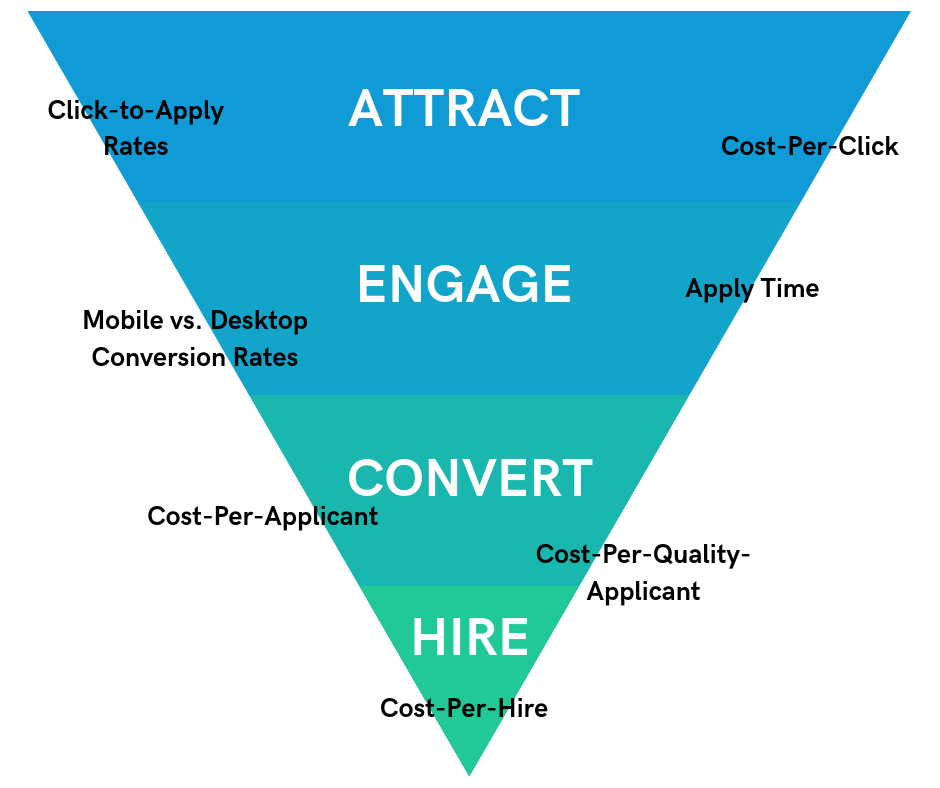Modern recruiters are masters of all trades – a bit of marketing know-how, with a dash of sales prowess, and, of course, a knack for human resources.
But this renaissance recruiter hasn’t appeared by accident; rather, it’s the result of major shifts within modern recruitment. Gone are the days where it was as simple as posting job ads and watching candidates flow in.
In the past, there were few sources to manage—those were the days of help wanted signs in shop windows. There’s a lot more to keep track of in today’s recruitment ecosystem, with differing types of ad buying, traffic across a variety of devices, and a plethora of application systems. And with all of these moving parts, how do you best measure your recruitment ROI to ensure your candidate sources and recruitment advertising are performing?
Knowing key recruitment media metrics can help you prove the ROI of your campaigns; after all, recruitment media is all about looking at the numbers.
With various metrics and benchmarks to keep track of, monitoring them all is a full-time job. It can be difficult to figure out just what matters (and what doesn’t) in recruitment media, and which metrics you should be paying the closest attention to. Never fear – we’ve compiled the most important metrics for tracking the success of your campaigns for tracking (and improving!) your recruitment ROI.
Media Metrics for Tracking (and Improving) Recruitment ROI
CPA (Cost Per Applicant)
Cost per applicant is how much it costs to get an applicant through your pipeline. Only completed applications are considered against the cost of advertising spend. You can make use of the CPA metric whether or not you’re actually using that payment model—simply divide your total spend by the number of applicants you receive.
More than any other, this metric tells you how much you’re really spending on your recruitment advertising efforts. Since this metric is concerned with the valuable resource of applicants, you can use it to determine the ROI of your recruitment spend.
CPA is the way forward in recruitment media. A burgeoning number of sites and software offer CPA models of ad buying, allowing their users to spend only on what matters most to them: completed applications. In this case, you’ll have the metric tracked for you as soon as you post your ad.
CPA is expressed in dollars.
CPC (Cost Per Click)
More likely than not, you’re already very familiar with cost-per-click. In recruitment, it’s the amount paid out when a job seeker clicks on an advertisement to view it. This is similar to a lot of other programmatic advertising systems, such as Google’s Doubleclick platform.
Many recruitment media publishers make use of cost-per-click models. The reason? Interest in the ad is what drives the value of each one, meaning that the more relevant, targeted, and enticing your ad is, the more clicks you’ll get (and subsequently, the more $ you’ll spend). Keeping track of this metric is essential to navigating the majority of job sites.
If you’re not tracking your cost-per-click bids already, you can determine it by taking the amount of money invested in your recruitment media and dividing that figure by overall clicks.
CPC is expressed in dollars.
CPQA (Cost Per Quality Applicant)
While getting applicants through your pipeline is all well and good, not all of those applicants may be the ones you’re looking for. Sometimes a job seeker lands on your ad, applies to your job, and simply doesn’t have enough experience. Or, maybe they’re based in the wrong location, don’t have a certain skill or certification you require, currently work in an unrelated field…the list can go on an on.
Whatever the case may be, determining what “quality” means is a question with a different answer for every organization. In the end, it’s up to you as the recruiter and the hiring manager to decide what “quality” really means.
Cost-per-quality-applicant takes your CPA, and figures out who among those applicants are worth following up with.
CPQA allows you to determine the overall effectiveness of your recruiting media from both a qualitative and quantitative standpoint. Qualitatively, for example, there’s a chance that the job seekers you want aren’t responding to your descriptions or titles in the way you intended. From this, you can determine whether or not you need to adjust your messaging, and you can make run tests to see what draws in the candidates you’re looking for. Quantitatively, CPQA can be used as a metric to figure out the effectiveness of your recruitment media placement. It gives you a more holistic way to look at your candidate sources, and can guide whether or not you need to tap into a new publisher, improve your network, or invest in technology.
CPQA is expressed in dollars.
CPH (Cost Per Hire)
Some studies have shown that time-to-hire is a falsified, inaccurate metric. It fails to capture all the factors of a position long unfilled. In reality, it’s only part of the overall cost of having an open position. Time-to-hire forgets the various levers available to recruiters – the days of posting an ad in the newspaper are long gone, and now recruitment is a far more interactive process.
Instead, consider the impact on your overall spend. According to Glassdoor, organizations sink an average of $4000 into one unfilled position. How much money have you spent on your openings?
CPH allows you to measure job openings by their direct impact on the organization and the hiring plan, rather than simply the hiring plan. A lot goes into cost per hire, such as the cost of recruitment media and the cost of covering the opening until it’s filled, thus providing a more accurate benchmark.
CPH is expressed in dollars.

Click-to-Apply Rates
Click-to-apply rates reflect how many job seekers who view your ad go on to complete the application.
Click-to-apply rates help measure how resonant your messaging is with job seekers, and a well-written job ad will help boost your apply rates. If your job ads are getting a lot of clicks, but low conversions, it can mean there’s a disconnect between your job title and job description and you should adjust your messaging.
Measuring your click-to-apply rate is valuable for understanding how your messaging also affects your bottom line. A poor click-to-apply rate can provide an early warning for a climbing spend, as you continue to drive job seekers to your applications (resulting in higher clicks, which in a CPC model, can get costly), but ultimately lose them in the process.
Additionally, you can use CTA rates to determine the effectiveness of job ad placements across your publishers. Does one publisher drive few clicks, but every click becomes an apply, or a lot of clicks with almost no applies?
CTA is expressed as a percentage.
Apply Time
Not to be confused with time-to-hire or time-to-fill, apply time is how long, on average, it takes a job seeker to complete your application. Every aspect of the apply process factors into the typical apply time. This includes the number of pages, complexity of the application itself, and any assessments or supplementary forms on top of that.
Apply time is important because shorter applications are more likely to be completed. In fact, our research has found that applications that take 5 minutes or less to complete can increase applicant flow by over 300%. What would you do with an extra 300% of applicants?
If you know that your apply process is 15 minutes or more, you may be able to increase the apply rates by cutting down on the paperwork. Applications with fewer questions to fill out cuts apply time and boosts apply rates. Skip the account sign up, and don’t make candidates fill our all of their resume information manually. You’ll thank us later.
Mobile vs. Desktop Conversion Rates
Perhaps one of the most important metrics in today’s recruitment ecosystem is that of the mobile conversion rate. It’s important to segment your analysis of your data by platform because compared to desktop, mobile applies are problematic.
While nearly 40% of job seeker traffic comes from a mobile device, only a tiny percentage of mobile job seekers (read: 5.1%) successfully complete their application. That’s a huge drop off, and a huge area of potential.
Apply time issues are magnified on mobile devices, which vary in their ability to display web pages, upload resumes, and complete other tasks of the apply process. A high apply time will have adverse effects on your mobile/desktop conversion rates.
Short of testing your apply process, analyzing the differences between mobile and desktop conversions can allow you to modify your apply process to be more friendly. Paying attention to the difference in conversion rates will allow you to improve your mobile application process, and prevent job seekers from abandoning their applications.
Learn more about the key media metrics you need to track, and improve, your recruitment ROI in our Guide to Performance Job Advertising.
This blog post was originally published on July 29, 2016 and has since been updated.

